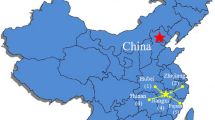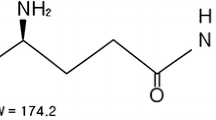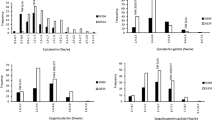Abstract
China has the most abundant tea resources in the world. In oder to scrutinize superior accessions suitable for popularization and planting, the quality characteristics of distinctive tea resources were analyzed by examining their key evaluation indexes and comprehensive evaluation methods. In this study, 29 indexes of 47 tea germplasms were detected, including agronomic characters, chemical compositions, quality of green tea and stress resistance. The key evaluation indexes were selected by factor analysis and cluster analysis, whereas the weight value of the indexes was determined by analytic hierarchy process (AHP) and entropy weight method. Furthermore, the comprehensive evaluation of tea varieties was carried out by grey correlation degree and entropy weight method. Our results showed that drastic differences of character indexes existed among tea varieties, and the 29 character indexes demonstrated complex information overlapping with each other. After simplification, 12 key evaluation indexes, namely score of green tea quality, total free amino acids, growth potential, water extract, yield, epigallocatechin gallate (EGCG), epigallocatechin (EGC), one bud one leaf stage, insect resistance, germination density, bud leaf color, and gallic acid (GA) were chosen. The weight value of each index was also determined. Since the rank of some varieties in these two evaluation methods was different, based on the comprehensive evaluation results of grey correlation degree method and entropy weight method, it was more rational to combine these two evaluation methods in selecting superior varieties. Consequently, nine excellent tea varieties were selected. This study not only provides an innovative method for comprehensive evaluation of tea resources, but also an approach to promote genetic improvement of the selected excellent tea varieties.



Similar content being viewed by others
References
An B, Lee CG, Song MK, Ryu JC, Lee S, Park SJ, Zhao DY, Kim SB, Park C, Lee SH, Hong SH, Choi JW (2015) Applicability and toxicity evaluation of an adsorbent based on jujube for the removal of toxic heavy metals. React Funct Polym 93:138–147
An D, Lai XF, Deng JQ, Han TF, Shen YY (2019) Evaluation of feeding potential of soybean varieties origin from Southern China by the method of TOPSIS. Acta Agrestia Sinica 27:1710–1717
Bai H, Feng F, Wang J, Wu TS (2020) A combination prediction model of long-term ionospheric foF2 based on entropy weight method. Entropy 22:442
Chen L, Zhou ZX (2005) Variations of main quality components of tea genetic resources [Camellia sinensis(L.) O. Kuntze] preserved in the china national germplasm tea repository. Plant Foods Hum Nutr 60:31–35
Das PR, Kim Y, Hong SJ, Eun JB (2019) Profiling of volatile and non-phenolic metabolites—amino acids, organic acids, and sugars of green tea extracts obtained by different extraction techniques. Food Chem 296:69–77
Deng JK, Liu X, Wu XY, Bi JF, Jiao Y, Zhong YG (2017) Quality evaluation of apple (substandard) juice from different cultivars based on analytic hierarchy process and grey interconnect degree analysis. J Chin Instit Food Sci Technol 17:197–208
Duan ZF, Liu BY, Wang YG, Xie J, Sun XM, Song WX, Yi B, Ma L (2013) Diversity analysis of agronomic traits of wild tea plants in Yunnan. Acta Agric Boreali Occidentalis Sinica 22:125–131
Francis W, Junichi T, Yoshiyuki T (2015) Genetic variation and differentiation in tea (Camellia Sinensis) germplasm revealed by RAPD and AFLP variation. J Hortic Sci Biotechnol 76:557–563
Fumiya T, Keiko K, Tetsuji S, Akiko O (2014) Worldwide core collections of tea (Camellia Sinensis) based on SSR markers. Tree Genet Genom 10:1555–1565
He W, Hu XS, Zhao L, Liao XJ, Zhang Y, Zhang MW, Wu JH (2009) Evaluation of Chinese tea by the electronic tongue: correlation with sensory properties and classification according to geographical origin and grade level. Food Res Int 42:1462–1467
Hu B, Wang HY, He LF, Li Y, Li C, Zhang ZQ, Liu YT, Zhou K, Zhang Q, Liu AP, Liu SX, Zhu YD, Luo QY (2018) A method for extracting oil from cherry seed by ultrasonic-microwave assisted aqueous enzymatic process and evaluation of its quality. J Chromatogr 1785:50–60
Hua JJ, Yuan HB, Yao YF, Jiang YW, Wang JJ (2018) Effect of temperature on color and tea pigment content of fermented tea leaves. Trans Chin Soc Agric Eng 339:300–308
Jian M, Fan ZP, Huang LH (1999) A subjective and objective integ rated approach to determine attribute weights. Eur J Oper Res 112:397–404
Law JR, Anderson SR, Jones ES, Nelson B, Smith SC (2011) Approaches to improve the determination of eligibility for plant variety protection:evaluation of morphological characteristics. Maydica 56:113–129
Liu BY, Cheng H, Li YY, Wang LY, Wang PS (2012) Fingerprinting for discriminating tea germplasm using inter-simple sequence repeat (ISSR) markers. Pak J Bot 44:1247–1260
Liu HH, Shan WN, Zhou M, Yu XM (2017) Draft genome sequence of paenibacillus sp. XY044, a potential plant growth promoter isolated from a tea plant. Genome Announc 5:16–17
Lopez SJ, Thomas J, Pius PK, Kumar RR, Muraleedharan N (2005) A reliable technique to identify superior quality clones from tea germplasm. Food Chem 91:771–778
Lv HP, Liang MZ, Zhang Y, Wang LB, Lin Z (2016) Major chemical components and antioxidant activity in tea infusion of tea products obtained from the special tea germplasm “Zijuan” using different processing technologies. Food Sci 37:122–127
Lv LL, Li W, Xiao XO, Gao XM (2017) Grey correlative degree analysis on the cold-resistant traits of parthenocarpic eggplant. J Agric Sci 9:95–104
Mani M, Misra A, Vethamony P (2018) A new insight to vulnerability of central odisha coast, India using analytical hierarchical process (AHP) based approach. J Coast Conserv 22:779–819
Ooi J, Promentilla MAB, Tan RR, Ng DKS, Chemmangattuvalappil NG (2018) Integration of fuzzy analytic hierarchy process into multi-objective computer aided molecular design. Comput Chem Eng 109:191–202
Riza T, Mustafa A, Mehmet BB, Cengiz C (2019) Efficacy evaluation of ultrasound treatment on the postharvest storability of white nectarine by both physicochemical and image processing analyses. Postharvest Biol Technol 154:41–51
Scharbert S, Holzmann N, Hofmann T (2004) Identification of the astringent taste compounds in black tea infusions by combining instrumental analysis and human bioresponse. J Agric Food Chem 52:3498–3508
Shi LQ, Zhang RG, Han J, Cong PZ, Qin DX, Guo YC (2020) Water inrush risk assessment with multi-source information type fusion based on EWM-AHP comprehensive weighting. J Henan Polytech Univ 39:17–25
Song XY, Qian GJ, Zhang SP, Yu Y, Li S, Bi SD, Zhou XZ, Zhou YD (2020) Relationship between the quantity, time, and space of three pests and their predatory natural enemies in Baihaozao tea garden. Acta Ecol Sinica 40:260–270
Wang MT (1999) A comprehensive analysis method on determining: the coefficients in multi-index evaluation. Syst Eng 17:56–61
Wang Y (2010) Application of grey relation projection method with variation coefficient weight for evaluation of water quality. Ground Water 101:73–79
Wang XM, Qin JC, Zhang Q, Chen WJ, Chen XL (2013) Mining method optimization of Gu Mountain stay ore based on AHP-TOPSIS evaluation model. J Cent South Univ 44:1131–1137
Wang XB, Wang H, Hu KM, Li YJ, Qin TY, Zeng WJ, Li X, Zhang KL, Zhang JL, Bai JP (2017) Comprehensive evaluation of introduced potato germplasms resources based on the analytical hierarchy process and GGE-biplot. J Plant Genet Resour 6:71–82
Wang ZH, Yue CN, Mao SH, Ye YL, Chen L, Tong HR (2018) Study on main flavoring compounds and taste acceptability of yellow tea. Food and Fermentation Industries 44:77–83
Wang XC, Wang L, Hao XY, Yang ZJM, YJ, (2019) 40 years of tea genetic breeding in China. China Tea 5:1–6
Wang ZH, Peng H, Jiang XF, Yang PX (2020) Analysis on the phenotypic diversity of buds and leaves of tea germplasm resources in Jiangxi Province. Jiangsu Agric Sci 48:134–142
Wu CY, Xu HR, Heritier JL, Andlauer W (2012) Determination of catechins and flavonol glycosides in Chinese tea varieties. Food Chem 132:144–149
Xing JF, Yuan XY (2017) Discussion on construction of electricity price analysis model based on factor analysis. Electr Eng 8:118–121
Yang C, Hu ZY, Lu ML, Li PL, Tan JF, Chen M, Lv HP, Zhu Y, Zhang Y, Guo L, Peng QH, Dai WD, Lin Z (2018a) Application of metabolomics profiling in the analysis of metabolites and taste quality in different subtypes of white tea. Food Res Int 106:909–919
Yang C, Chen ZW, Guo Y, Qiao DH, Li S, Meng ZH (2018b) Comparison of apolygus lucorum resistance and volatile constituents in different tea cultivars. J Henan Agric Sci 47:95–99
Yang HY, Liu HJ, Zhang NM, He T, Deng H, Bao L (2020) Effects of different fertilization application reduction methods on tea garden soil nutrient and tea quality. J South Agric 51:887–896
Yao MZ, Ma CL, Qiao TT, Jin JQ, Chen L (2012) Diversity distribution and population structure of tea germplasms in China revealed by EST-SSR markers. Tree Genet Genomes 8:205–220
Yu PG, Yeo SL, Low MY, Zhou WB (2014) Identifying key non-volatile compounds in ready-to-drink green tea and their impact on taste profile. Food Chem 155:9–16
Yue CN, Wang ZH, Mao SH, Li XY, Tong HR (2017) The main taste substances in tea research progress. Food Res Dev 1:228–233
Zhang LW (2019) Comparison of aroma chemical components between old and new tea trees of Fenghuangdancong tea. Food and Ferment Indus 45:228–234
Zhang Y, Zhong YF, Yuan LY, Luo HY, Wu XH (2015b) Study on different grade tea quality characteristics of Yunling-Yongchuan-Xiuya. Southwest China J Agric Sci 28:84–89
Zhang XQ, Zhou FY, Yang C, Zhang ZQ, Hu JQ (2015a) Diversity of tea germplasm resource (Camellia sinensis ‘Guiding-niaowa-ngzhong’) revealed based on agronomic and quality traits. Mol Plant Breed 2:415–423
Acknowledgments
This research was funded by Jiangxi Key Laboratory of Tea Quality and Safety Control (20192BCD40007), Modern Agricultural Industrial Technology System of Jiangxi Province (JXARS-02), National Modern Industrial Technology System (CARS-19), Science and Technology Project of Jiangxi Province (20143ACF60006).
Author information
Authors and Affiliations
Corresponding author
Ethics declarations
Conflict of interest
The authors declare that they have no conflict of interest.
Additional information
Publisher's Note
Springer Nature remains neutral with regard to jurisdictional claims in published maps and institutional affiliations.
Supplementary Information
Below is the link to the electronic supplementary material.
Rights and permissions
About this article
Cite this article
Wang, Z., Yang, P., Peng, H. et al. Comprehensive evaluation of 47 tea [Camellia sinensis (L.) O. Kuntze] germplasm based on entropy weight method and grey relational degree. Genet Resour Crop Evol 68, 3257–3270 (2021). https://doi.org/10.1007/s10722-021-01184-7
Received:
Accepted:
Published:
Issue Date:
DOI: https://doi.org/10.1007/s10722-021-01184-7




